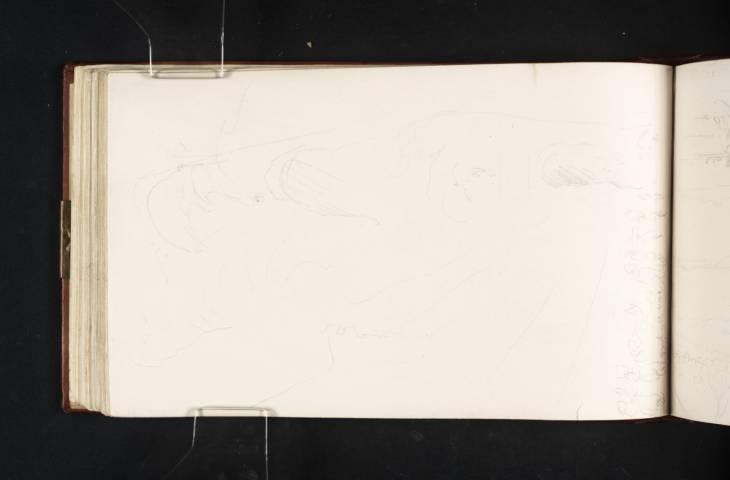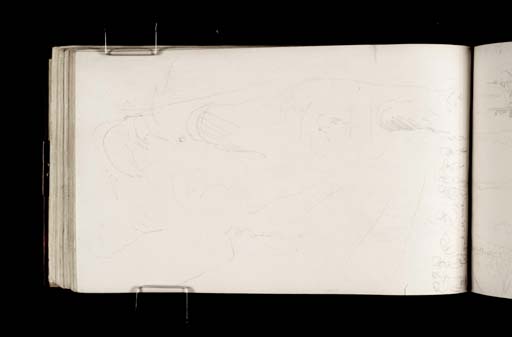Joseph Mallord William Turner Entrance to the Grotto of Posillipo, Naples 1819
Image 1 of 2
Joseph Mallord William Turner,
Entrance to the Grotto of Posillipo, Naples
1819
Joseph Mallord William Turner 1775–1851
Folio 54 Verso:
Entrance to the Grotto of Posillipo, Naples 1819
D15661
Turner Bequest CLXXXIV 52 a
Turner Bequest CLXXXIV 52 a
Pencil on white wove paper, 197 x 122 mm
Inscribed by the artist in pencil ‘monk with wine’ bottom left
Accepted by the nation as part of the Turner Bequest 1856
References
1909
A.J. Finberg, A Complete Inventory of the Drawings of the Turner Bequest, London 1909, vol.I, p.544, as ‘Do. [Entrance to the Grotto of Posilipo]; figures in foreground, among them a “Monk carrying wine” ’.
1984
Cecilia Powell, ‘Turner on Classic Ground: His Visits to Central and Southern Italy and Related Paintings and Drawings’, unpublished Ph.D thesis, Courtauld Institute of Art, University of London 1984, p.180 note 42.
1987
Cecilia Powell, Turner in the South: Rome, Naples, Florence, New Haven and London 1987, p.79 note 35].
This slight sketch, as well as other related drawings on folios 53 verso and 54 (D15659 and D15660; Turner Bequest CLXXXIV 51a and 52), represent Turner’s impressions of his experience walking through the Grotto of Posillipo (known today as the Crypta Neapolitana), a Roman tunnel through the Posillipo Hill which was built during the first century BC in order to link Naples with Pozzuoli to the west. An impressive feat of ancient engineering, legend had it that the tunnel been magically created by the classical poet, Virgil, whose villa was said to be nearby. Nearly half a mile in length, it was both an important thoroughfare and a popular tourist attraction, and represented an established motif for British artists visiting the city.1
The clear arched outlines near the top centre and bottom right-hand corner of this study suggest that Turner was standing just inside the entrance to the tunnel, where the rough, cragginess of the rock was moulded into more defined architectural forms. A stream of fellow travellers is pictured approaching the opening, poised to enter its dark cavernous depths. A more detailed and conventional view of the entrance to the Grotto can be seen in the Naples, Rome C. Studies sketchbook (Tate D16098; Turner Bequest CLXXXVII 11).
Nicola Moorby
April 2010
Images of the tunnel include, for example, Thomas Jones (1742–1803), The Grotto of Posillipo, oil on paper, 1782 (Gere Collection), William Pars (1742–82), The Grotto at Posillipo (Birmingham City Museum and Art Gallery) and Francis Towne (1740–1816), The Grotto at Posillipo, watercolour, 1781 (British Museum), all reproduced in colour in Anna Ottani Cavina, Un Paese Incantato: Italia Dipinta da Thomas Jones a Corot, exhibition catalogue, Galeries nationales du Grand Palais, Parigi and Palazzo Te, Mantova, Italy 2001, nos.38–40, pp.60–3, and Francis W. Hawcroft, Travels in Italy 1776–1783: Based on the ‘Memoirs’ of Thomas Jones, exhibition catalogue, Whitworth Art Gallery, Manchester 1988, nos.132–5, pp.111 and 116. See also John ‘Warwick’ Smith (1749–1831), Grotto of Pausilippo 1778–9, watercolour (Tate, T08492), and drawings by James Hakewill (1778–1843), reproduced in Tony Cubberley and Luke Herrmann, Twilight of the Grand Tour: A catalogue of the drawings by James Hakewill in the British School at Rome Library, Rome 1992, nos.5.51–2, pp.281–3.
How to cite
Nicola Moorby, ‘Entrance to the Grotto of Posillipo, Naples 1819 by Joseph Mallord William Turner’, catalogue entry, April 2010, in David Blayney Brown (ed.), J.M.W. Turner: Sketchbooks, Drawings and Watercolours, Tate Research Publication, December 2012, https://www


